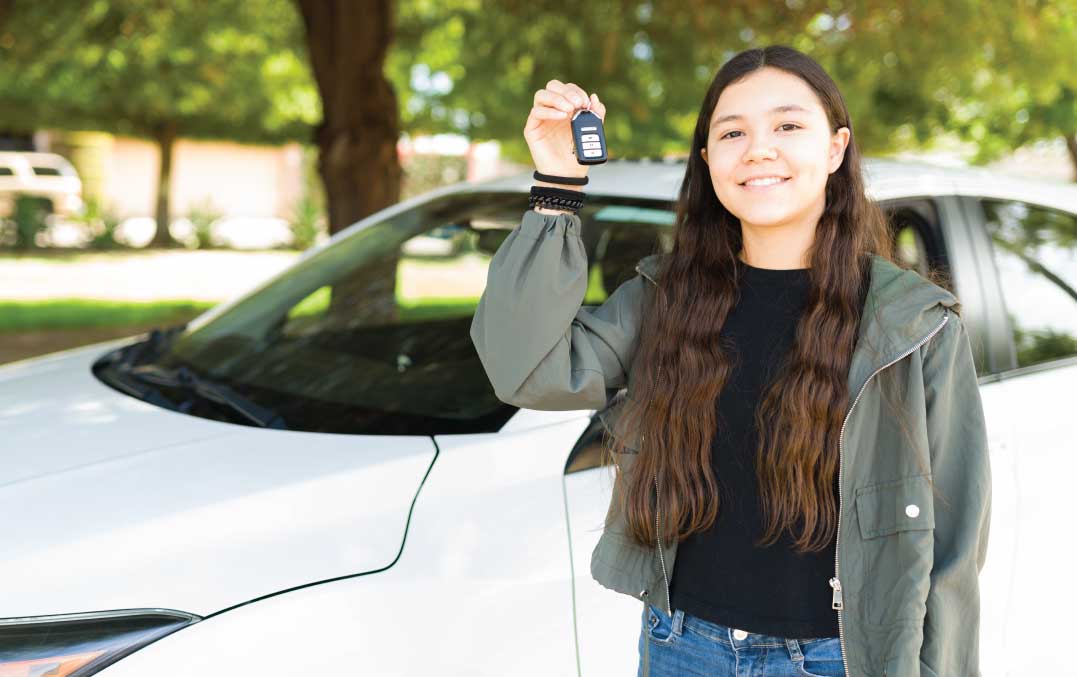Buying a car for your child is a big decision. So we’ve prepared some tips to help parents buy their child a first car.
Owning a car is a rite of passage, one that leads to greater independence and responsibility. As a teenager or young adult, the idea of getting your first car is really exciting! Coming up with the money to pay for their first car is much less exciting though — and that’s where mum and dad come in! If you’re thinking about buying a car for your child, it is a hefty decision. We’ve prepared some tips to help you through the process of buying your child their first car.
Cars aren’t cheap and will likely be the most expensive gift you’ve bought for your child to date. Before beginning the car search, it’s a good idea to work out how much you’d like to spend on a vehicle.
While older, cheaper cars are available on the market, it’s important to consider safety features. A car from the ’90s might’ve had state of the art safety features for the time, but compared to what’s available in newer cars today, a dated model may seem like an accident waiting to happen.
When setting the budget, keep in mind that keeping costs low could mean forgoing reliability and certain safety features. This is only a general rule of thumb and is not always true; you might find an absolute bargain out there. It comes down to what you’re comfortable with your child driving and what you’re happy to spend.
If you’d like to finance a car so you can pay it off rather than coughing up a lump sum, it may be worth considering applying for a car loan.
Apply for a Car Loan
As an alternative to covering the total costs of a car for your child, you could tell them you plan to help them buy a car by matching any amount they are able to save. This gives them an incentive to save as much as they can and is a good lesson in responsible money management.
Once you have set the budget and secured the money (and have room to squeeze another car in the driveway), it’s time for the big reveal.
Explain to your child you plan to buy them a car and get their thoughts on what sort of vehicle they think would be suitable. It’s a good idea to ask for their thoughts regardless of whether you will be the one dictating the make and model. They may have valid points as to why they need a sports car that you hadn’t thought of!
Your child will likely be excited about the idea, but this is a good time to lower their expectations and make it clear that owning a car is a huge responsibility that comes with a number of ongoing costs like petrol, repairs, insurance, registration and tyres. Decide what expenses your child will be responsible for. Will your child need to contribute to the overall cost of the vehicle?
If you buy the car under your name instead of your child’s, you remain in control of the car and have the power to take the car back. Regardless of whose name the vehicle is in, be sure to have your child listed as a driver on the insurance. This may make the premiums slightly higher, but should ensure your child is covered in the case of an accident.
Once you’ve identified what kind of car is best suited to your child, researched the features, and you’ve got a rough idea of whether you’re looking for new or used vehicle, it’s time to include your child in the car shopping process!
When buying a car, you can purchase it through a dealer or a private seller. You’ll find car ads online and even on social media platforms such as Facebook. If you’d like to browse through a variety of cars, going for a look at a dealership may be a good idea. When looking at cars, encourage your child to ask the salespeople questions — after all, they’ll be the one driving the vehicle.
Go for a test drive and determine whether your child likes the feel of the car. The car you buy your child may handle differently to the car they have been practising in. It is highly recommended that your child becomes familiar with their first car. This may take a bit of time.
The biggest killer of young drivers is speeding, so it’s important your child always sticks to the speed limits. Remind your child that having a licence and owning a car does not make them exempt from road rules — and perhaps you’ll enforce extra rules if they can’t stick to the law.
Basic distractions should be limited and discouraged while driving. Some suggestions include:
- Turning phones off while driving.
- No eating in the car.
- No music/radio for the first year.
- No driving while angry or sad (teenagers can be emotionally volatile and may endanger themselves).
It may be worthwhile accompanying your licenced child for their first few drives in their new car, or at least until you are confident that your child is capable of driving without supervision. This isn’t just for your peace of mind — driving alone for the first time in a new car can be really nerve-wracking for young drivers. Having you there with them can help them feel more comfortable. Another suggestion is to limit the number of passengers your child is allowed to carry. Showing off in front of peers can quickly become dangerous while behind the wheel.
Buying your child’s first car is an exciting time that can also come with some stressors. Keeping an open line of communication with your child throughout the buying process and their early driving years can help smooth the transition from child to responsible car owner.
Disclaimer: The information above is of a general nature only and does not consider your personal objectives, financial situation or particular needs. You should consider seeking independent advice regarding your legal, financial, taxation or other needs, to check how the information relates to your particular circumstances. We do not accept responsibility for any loss arising from the use of, or reliance on, the information. All loan applications are subject to normal lending criteria. Fees and charges payable. Terms and conditions apply.



